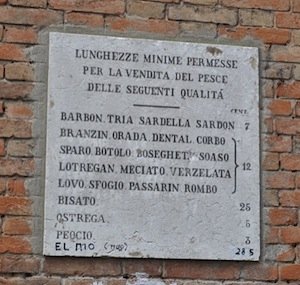When, as restaurateurs, we’re about to buy some fish, do we ever wonder if the catch of the day is legal and ethical? Already in 1173 an edict of the Republic of Venice informed consumers on the minimum size of the fish one should buy, imposing precise and strict rules. An ancient plaque at the entrance of the market in Rialto indicates even today the minimal length for the catch of some species of fish in order to preserve their growth: from the 12 centimetres of the bass (today they’ve become 25) to the 3 for mussels (here called peoci). This edict anticipates what 900 years later would be the content of the decree 1967/2006 also known as “Decreto Mediterraneo” (here the complete text).

Old sign out of Rialto market in Venice
Respecting the size of fish means allowing each being in the sea to reproduce at least once in their life. And it means allowing the fishermen of the future to continue to live thanks to the resources offered by the sea. A team of scientists, constantly updated, periodically re-determines the minimum size for each species, monitoring the reproductive rhythms of each animal. The Decreto Mediterraneo, which entered into force only in 2010, after years of postponements, on top of indicating the minimum sizes, has also imposed the replacement of all the trailing nets on trawlers: by law, links now need to be 50 mm large instead of 40 as before.
Can one extra centimetre alone change the destiny of the catch? Of course not, but in order not to jeopardise the work of thousands of workers everything needs to be applied gradually. For sure, since the decree has been really put into force, it’s more and more rare to find in the markets the so called “frittura di paranza”, that mix of small cod, mullet and brill which, though fantastic when eaten fried (together with the fish bones), if not caught will double their weight allowing us to taste many more larger sized cod, mullet and brill.
A table indicates all the most frequently consumed species with reference to their measurement (
attachment III of the 1967/2006 decree). It’s important, however, to pay attention to how this measurement must be made: while fish which have a fishbone need to be measured as a whole (LT= lunghezza totale, total length), placing a ruler at the beginning of the mouth to the end of the tail, for crustaceans and sea food it’s another matter: in their case one needs to measure the total length (LT) not counting the claws or the length of the carapace (LC= carapace length), that is to say the top part, between the nib and the beginning of the abdomen. For the sea food one usually considers the total length as the diameter of the shell, excluding the long shaped ones as razor clams for which the total length needs to be considered.
As for the restaurateur who buys under-sized fish, he can be forced to pay a big fine, but there are also penal penalties: the purchase of protected species or in a size below the one indicated by the law favours illegal fishing. Unfortunately, while it is clear on earth that it’s best to eat the egg instead of the hen, only few understand that when it comes to the sea it’s best to eat the hen, and not the egg.